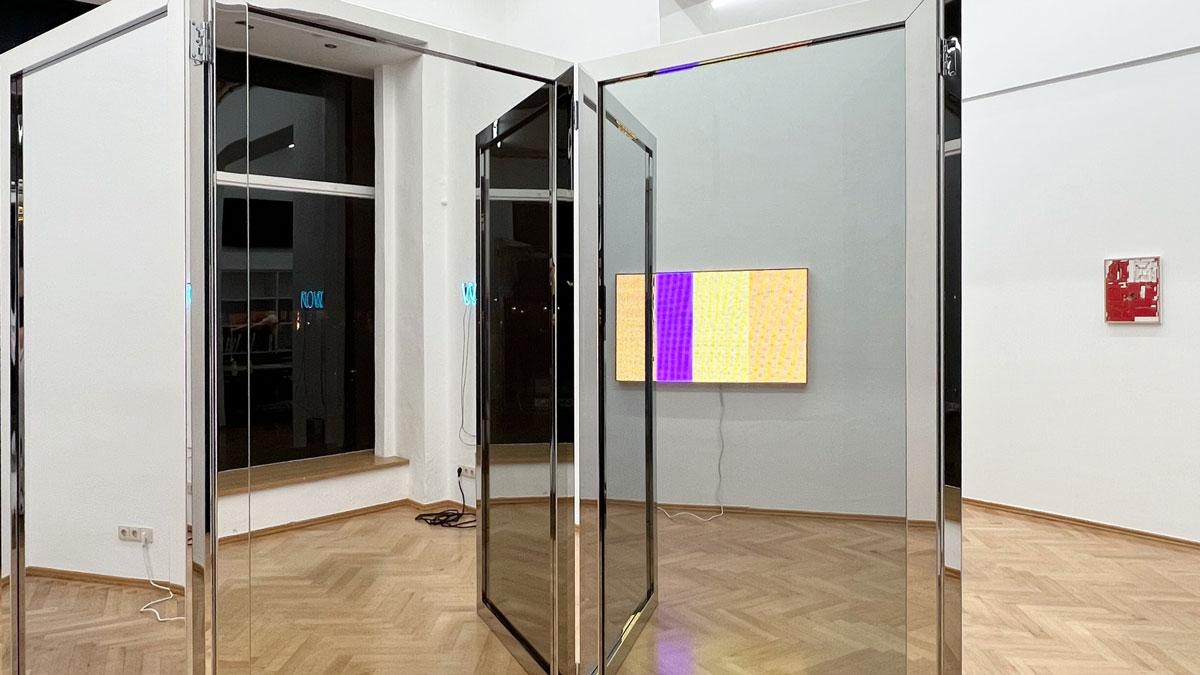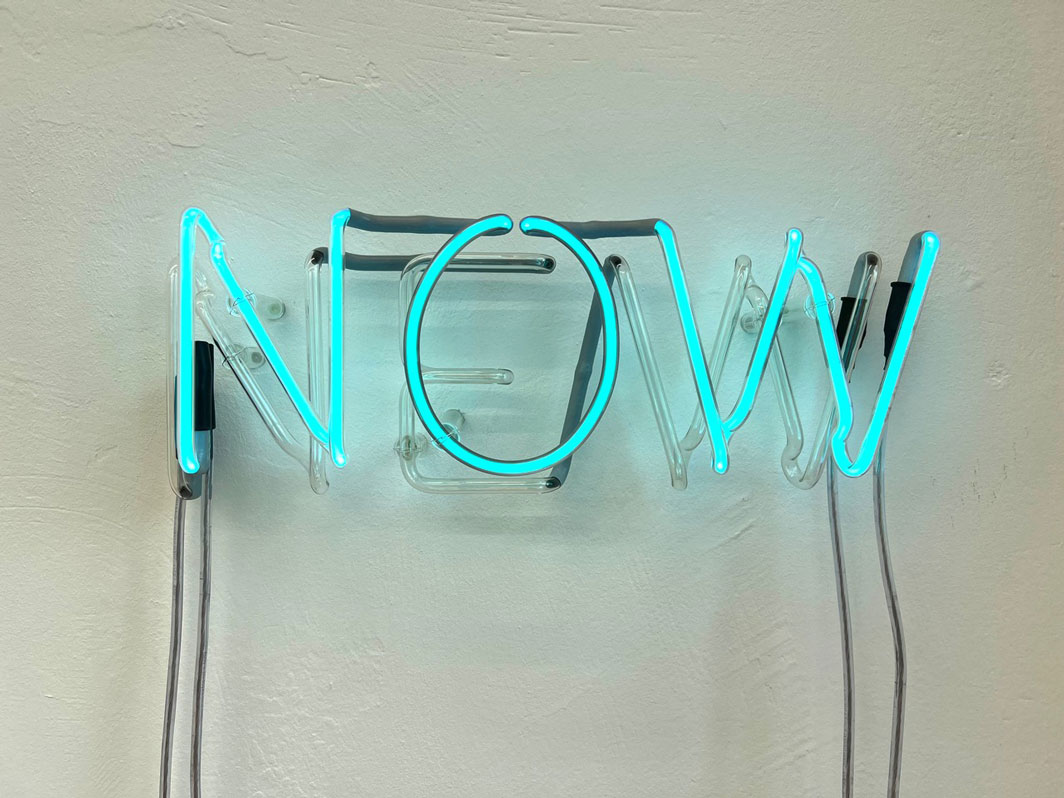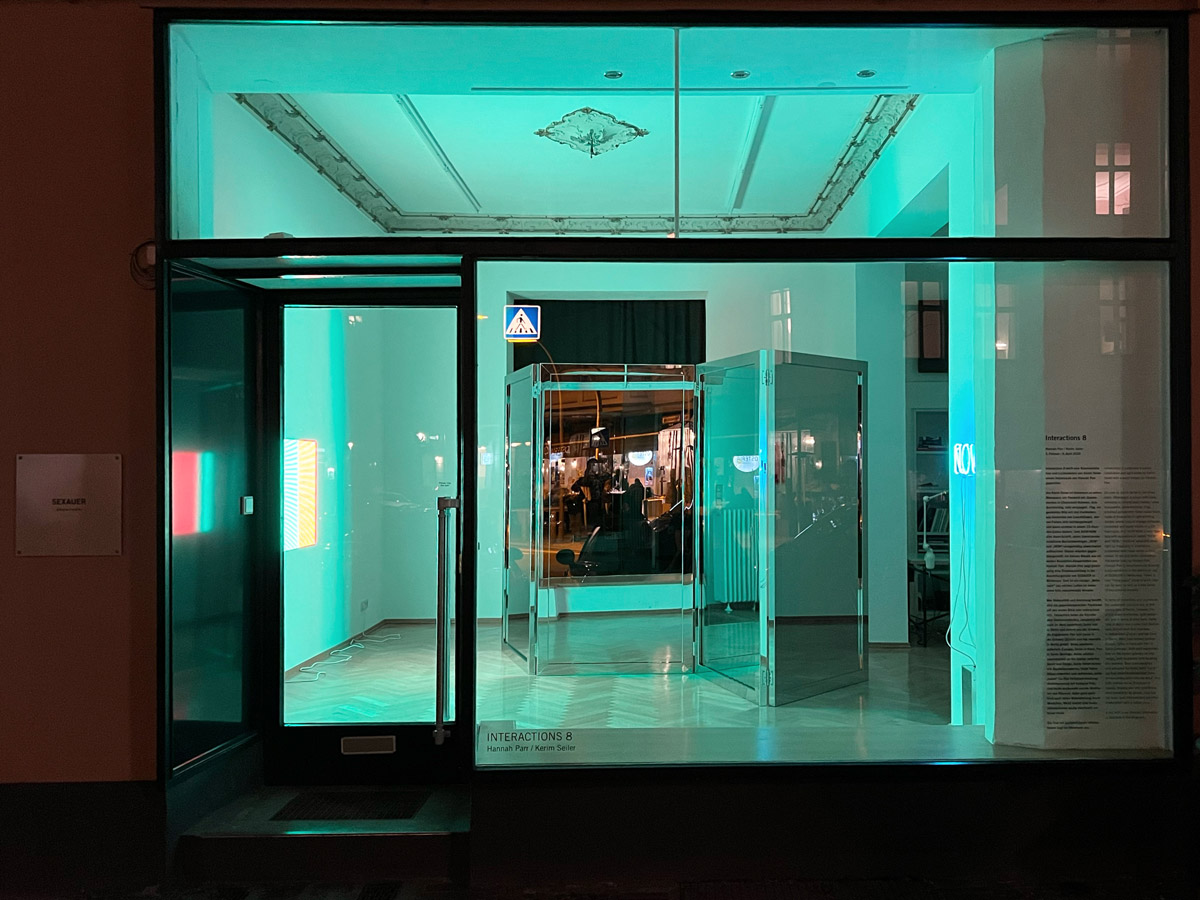








(english version below)
Interactions 8
stellt eine Rauminstallation und Lichtarbeiten von Kerim Seiler einem kleinen Holzmosaik von Hannah Parr gegenüber. Parr zeigt gleichzeitig eine Einzelausstellung in der Ausstellungshalle von SEXAUER in Weißensee.
Sowohl Parr wie Seiler „zeichnen“ häufig mit Holz im Raum oder auch wie hier im Showroom mit Licht (Seiler). Wie Architekten schaffen sie Räume und untersuchen den privaten wie den öffentlichen sowie dessen Wahrnehmung und Nutzung.
Von Kerim Seiler im Showroom zu sehen: Metaspace, ein Paravent mit Glaselementen in Chromstahl-Rahmen, teils durchsichtig, teils verspiegelt. Flag, ein gerahmtes Bild mit drei Farbfeldern aus tausenden von Leuchtdioden, dessen Farben sich rechnergesteuert und kaum sichtbar in einem 23-Stunden-Zyklus ändern. Und NEW/NOW, eine Neon-Schrift, deren übereinander installierte Buchstabenfolgen „NEW“ und „NOW“ unregelmäßig abwechselnd aufleuchten. Diesen Arbeiten von Seiler gegenübergestellt: ein kleines Mosaik aus rot-weißen Baustellen-Absperrlatten von Hannah Parr. (In Weißensee ist ein riesiger „Wohnraum“ von Parr aus solchen Latten zu sehen.)
Was Materialität und Anmutung betrifft, sind die gegenübergestellten Positionen auf den ersten Blick sehr unterschiedlich. Tatsächlich teilen die Künstler aber Gemeinsamkeiten, persönlich wie auch ihr Werk betreffend: Seiler lebt in Berlin und kommt aus der Schweiz; die Engländerin Parr lebt heute in der Schweiz (Zürich) und hat ebenfalls in Berlin gelebt. Beide arbeiteten außerhalb Europas, Seiler in Kairo, Parr in Santo Domingo. Beide arbeiten experimentell an der Grenze zwischen Kunst und Design, beide immer wieder mit Baustellenmaterial, beide haben Möbel entworfen und verfremdet, beide „malen“ (so ihre Selbstbeschreibung) dreidimensional mit farbigem Holz und beide analysieren soziale Strukturen von Räumen, dabei ganz spezifisch auch deren Wahrnehmung durch Menschen. Nicht zuletzt sind beider Interventionen häufig durchsetzt von einer feinen Ironie.
Der Paravent Metaspace von Seiler teilt nicht nur den Raum, sondern er „vergrößert“ diesen durch die Spiegel und setzt – sobald Besucher kommen – ein bewegtes Bild in diesen. Weil die Elemente des Paravents durchsichtig sind oder spiegeln, wird ihr eigentlicher Zweck, nämlich Sichtschutz zu bieten oder Raumteile zu trennen, visuell in sein Gegenteil verkehrt.
Jeder Raum wird erst durch seine Nutzung konkretisiert und „definiert“. So kann Raum zusammenführen oder trennen, einsperren oder Schutz bieten. Durch die Raumtrennung mit Durchblicken und Spiegelungen wird diese Nutzungsabhängigkeit ins Bewusstsein gebracht. Darüber hinaus animiert Metaspace die Besucher, sich zu bewegen, zum Spiel mit dem Raum – vor oder hinter die Elemente zu treten – und inspiriert wortwörtlich zur Selbstbetrachtung. In der Ausstellung Interactions 8 kommt noch der Umstand hinzu, dass Metaspace die anderen Werke auf dem Glas und den Spiegeln reflektiert und somit „vervielfältigt“.
Flag ist eine Farbfeldmalerei mit Licht. Seiler setzt sich hier mit den Grundfarben des Lichts und der Malerei auseinander. Die Arbeit zeigt nicht nur eine „Trikolore“, sie zeigt auch einen Farbgradienten (Farbverlauf), allerdings nicht als statisches Bild, sondern in der Zeit. Durch eine Nutzung und Vermengung verschiedener Farbsysteme entstehen unkonventionelle Kompositionen, die darauf hindeuten, dass das „Erkennen“ von Farbe nicht zuletzt durch kulturelle Prägungen bestimmt wird. Seit der Antike gibt es verschiedenste Farbtheorien, die Farben und deren Wahrnehmung auf unterschiedlichen Feldern wie der Kunst, Physik, Physiologie oder Psychologie untersuchen. Die (eine und richtige) Farbenlehre gibt es nicht. Über das Feld der Farbenlehre und –wahrnehmung hinaus, ist die Arbeit Flag aufgrund ihres Titels und der Assoziation zu „Trikoloren“ auch politisch zu lesen. Aber das ist ein anderes Feld.
NEW/NOW ist – wie fast alle Neonarbeiten für Seiler – eine „Zeichnung im Raum“ oder umgekehrt formuliert – ebenfalls Zitat Seiler: space is my canvas. Zwei Wörter im Raum, unterschieden durch einen Buchstaben. New und Now. Zwei Wörter mit phonetischer, aber auch semantischer Nähe. Nähe, aber nicht Deckung. Auch die Neonröhren decken sich nicht exakt, sonst könnte man das untere Wort nicht sehen.
Semantisch wird man konstatieren können: Alles was neu ist, ist auch jetzt (sonst wäre es nicht neu, sondern alt). Aber nicht alles, was jetzt ist, ist auch neu. Dadurch aber, dass alles Neue auch jetzt ist (siehe oben), ist auch jetzt vieles neu. Moment! Stimmt das überhaupt? Vielleicht hatte Salomo Recht, der konstatierte: Es gibt nichts Neues unter der Sonne. Trifft dies möglicherweise zu, weil schon immer jetzt war? Oder vielleicht auch, weil es überhaupt nur jetzt gibt – und der Rest: Konstruktion, Erinnerung, Projektion. Oder umgekehrt: Gibt es kein Jetzt, sondern nur ein Nichts zwischen Zukunft und Vergangenheit? Fängt man an, darüber nachzudenken, flackert es einem vor Augen, fast wie vor NEW/NOW.
Das rot-weiße Holzmosaik von Hannah Parr aus Baustellen-Absperrlatten ist nur ein kleiner Verweis auf ihre große Ausstellung Hidden home in Weißensee. Betritt man dort die Ausstellungshalle, befindet man sich in einem gigantischen Wohnraum: Doppelbett, Schrank, Bügelbrett, Bilder, alles aus rot-weiß gestreiften Baustellen-Absperrlatten bzw. Teilen derselben. Die zunächst rein abstrakt erscheinenden Mosaike zeigen oft – nicht immer – stark abstrahierte Gegenstände, wie zum Beispiel Landschaften.
Was ist das für eine heimelige und doch fremde Welt, was für ein Hidden home von Hannah Parr? Baustellenlatten kommen sonst nur in der Öffentlichkeit zum Einsatz. Sie dienen der Abgrenzung, aber auch der Warnung. Parr versetzt sie ins Private. Dieses – im Wortsinn – sperrige Material dient Parr zur Konstruktion einer Heimstatt, die Archetypisches und Unbekanntes verbindet. Die Künstlerin zeigt uns ein Heim, das uns wie gewohnt umgibt, aber andererseits auch auf ein Heim in uns selbst verweist und auf eines jenseits unserer Wirklichkeit. Vielleicht auf eine Terra incognita. So nannten Europäer im 15. und 16. Jahrhundert die noch nicht von ihnen „entdeckten“ Gebiete. Im 19. Jahrhundert kam die Erkundung des – als „Seele“ bezeichneten – „inneren“ Ichs hinzu. Ähnlich jener Entdeckungsfahrten ins Unbekannte und Unbewusste „zeichnet“ Parr mit Holzstückchen ihre eigene Suche auf. Dabei kartographiert sie die Außenwelt und ihr Inneres in künstlerisch transformierter Nachfolge der Entdecker von Landmassen und Unterbewusstsein.
Bei den im vorhergehenden Absatz genannten Entdeckungsreisen treffen sich Parr und Seiler dann wieder: Seiler stieg einmal auf den Tafelberg in Südafrika, um mittels einer Neon-Installation dort in Raum und Himmel zu zeichnen. Zum Tafelberg und darüber hinaus hat uns, jedenfalls geistig, auch schon Parr auf die Reise geschickt. Mit ihren riesigen Mosaiklandschaften in künstlerisch transformierter Nachfolge früherer Entdecker, nur dass es Seiler und Parr nicht um Eroberung und Handelswege geht, sondern um das Offenhalten von Raum und dessen Zugang für alle. NOW!
Interactions 8
Juxtaposes a spatial installation and light works by Kerim Seiler with a wood mosaic by Hannah Parr.
Both Parr and Seiler often “draw” with wood in space or light (Seiler), as here in the showroom. Like architects, they create spaces and investigate the private and public space and their perception and use.
On view by Kerim Seiler in the showroom: Metaspace, a screen with glass elements in chrome steel frames, some transparent, some mirrored. Flag, a framed picture with three colour fields made of thousands of light-emitting diodes, whose colours change computer-controlled and barely visible in a 23-hour cycle. And NEW/NOW, a neon typeface with sequences of letters “NEW” and “NOW,” installed above the other, light up irregularly in alternation. Juxtaposed with these works: a small mosaic of red and white construction site barrier slats by Hannah Parr. Hannah Parr is simultaneously showing a solo exhibition in the exhibition hall of SEXAUER in Weißensee. There, a vast “living space” made of such slats can be seen, as well as a new series of monumental mosaics.
In terms of materiality and impression, the juxtaposed positions are, at first glance, very different. However, the artists share similarities, both personally and in terms of their work: Seiler lives in Berlin and comes from Switzerland; British born Parr now lives in Switzerland (Zurich) and has lived in Berlin. Both have worked outside Europe, Seiler in Cairo and Parr in Santo Domingo. Both work experimentally on the border between art and design, both repeatedly with building site material. Both have designed and alienated furniture, both “paint” (as they describe themselves) three-dimensionally with coloured wood. And both analyze social structures of spaces, thereby also very specifically their perception by people. Last but not least, both interventions are often interspersed with a subtle irony.
Seiler’s screen Metaspace not only divides the space but also “enlarges” it through the mirrors and places a moving image in it as soon as visitors arrive. Because the screen elements are transparent or mirrored, their actual purpose – to provide privacy or separate parts of the room – is visually reversed into its opposite.
Each room is only concretized and “defined” by its use. In this way, space can bring together or separate, enclose or offer protection. The separation of space with vistas and reflections brings this dependence on use into consciousness. Furthermore, Metaspace encourages visitors to move, play with space, step in front of or behind the elements, and literally inspire introspection. In the Interactions 8 exhibition, there is the added fact that Metaspace reflects and thus “multiplies” the other works on the glass and mirrors.
Flag is a colour field painting with light. Here, Seiler deals with primary colours of light and painting. The work not only shows a “tricolour”, but it also shows a colour gradient, not as a static image, but in time. By using and mixing different colour systems, unconventional compositions are created, which indicate that the “recognition” of colour is determined not least by cultural imprints. Since antiquity, various colour theories have examined colours and their perception in different fields such as art, physics, physiology, or psychology. However, the (one and correct) colour theory does not exist. Beyond the field of colour theory and perception, the work Flag can also be read politically due to its title and association to “tricolours”. But that is another field.
NEW/NOW is – like almost all neon works for Seiler – a “drawing in space” or formulated the other way around – also quoting Seiler: space is my canvas. Two words in space, distinguished by one letter. Two words with phonetic but also semantic proximity. Proximity, but not congruence. Even the neon tubes do not coincide exactly. Otherwise, one could not see the lower word.
Semantically, one will state: Everything new is also now (otherwise, it would not be new, but old). But not everything that is now is also new. But by the fact that everything new is also now (see above), also now often is new. Wait a minute! Is this true at all? Perhaps Solomon was right, who stated: There is nothing new under the sun. Is this possibly true because it has always been now? Or maybe because there is only now at all – and the rest: construction, memory, projection. Or vice versa: Is there no now, but only a nothingness between future and past? If you start to think about it, it flickers before your eyes, almost like NEW/NOW.
Hannah Parr’s red and white wooden mosaic made of construction site barrier slats is a small reference to her current exhibition Hidden home in Weißensee. When you enter the exhibition hall there, you find yourself in a gigantic living room: double bed, closet, ironing board, pictures, all made of red-and-white striped construction site barrier slats that have been cut into thousands of pieces and reassembled as mosaic-like structures. The mosaics, which at first seem purely abstract, can be seen as radically abstracted landscapes that evoke dual or multifaceted impressions – Images that proceed associatively in all directions.
What kind of a constructed and deconstructed, what kind of a homely and yet also strange, what kind of a familiar but also irritating world? What kind of hidden home is this? The exhibition’s title points to ambivalence and contradictions in itself. A home indeed, but a hidden one. Near and far at the same time. Accessible and blocked. Construction site slats are otherwise only used in public. They serve as a demarcation but also as a warning. Parr transposes them into the private sphere. This material serves Parr to construct a home that combines the archetypal and the unknown. The artist shows us a home that surrounds us as usual, but on the other hand, also refers to a home within ourselves and to one beyond our known reality, to a terra incognita. Terra incognita is what 15th and 16th century Europeans called places they had not yet “discovered” or mapped. They went in search of “new worlds.” In the 19th century, the exploration of the inner self, or the “mind,” began later to become known as psychoanalysis. Like those voyages of discovery into the unknown and unconscious, Parr “draws” her own search with pieces of wood. In doing so, she maps the outside world and her inner self in artistically transformed succession to the explorers of landmasses and the subconscious.
Parr and Seiler then meet again on the journeys of discovery: Seiler once climbed Table Mountain in South Africa to draw out space and sky there by means of a neon installation. But, to Table Mountain and beyond, at least mentally, Parr has also already sent us on a journey. With her vast mosaic landscapes in an artistically transformed succession to former explorers … only that Seiler and Parr are not concerned with conquest and trade routes, but with keeping space open and making it accessible to all. NOW!

